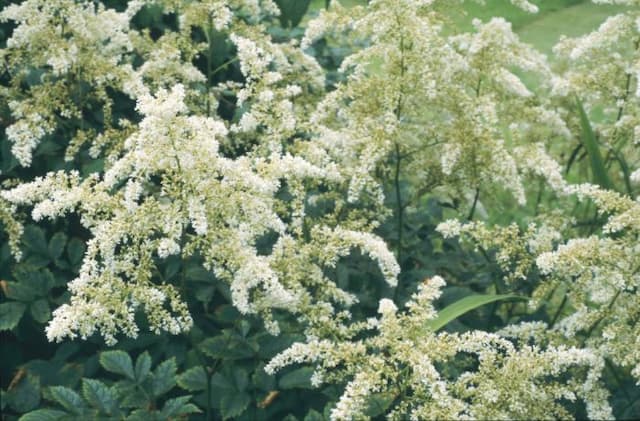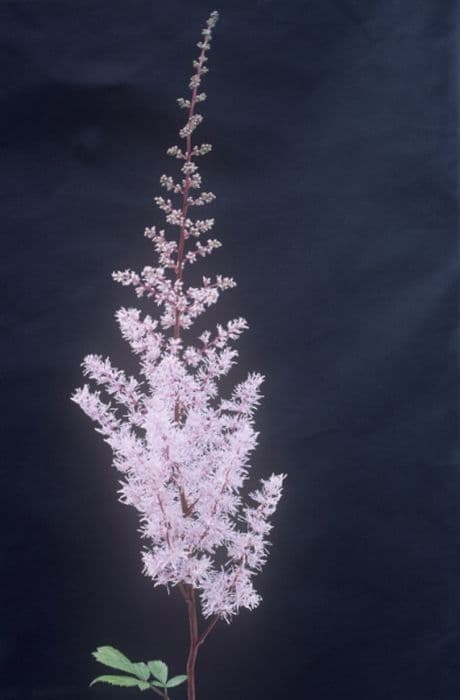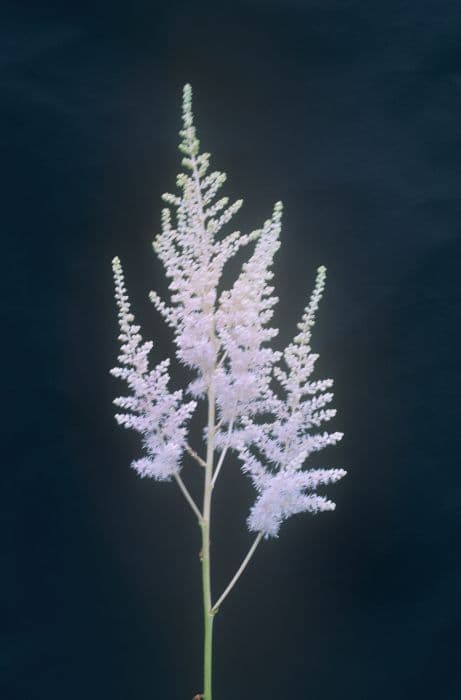Rock Astilbe Astilbe glaberrima var. saxatilis

ABOUT
Astilbe, commonly known for its delicate and frothy plumes, is a perennial favored for its graceful and feathery flower spikes. It boasts a floriferous appeal, with its flower clusters presenting a feathery silhouette and often found in a range of hues that can include shades of white, pink, or red, offering a visually soft and airy display. The flowers are held aloft on slender, branching stems that rise above the plant's mound-like foliage. The leaves of Astilbe are usually deeply divided and fern-like in appearance, creating a lush, finely textured mound of greenery. These leaves can vary in color from deep green to bronze-tinted green, contributing to the plant's ornamental value even when it is not in bloom. Astilbe also has a charming attribute of being attractive to butterflies, bringing an added layer of liveliness to gardens or naturalized settings. With its elegant and whispery flower plumes dancing atop the rich foliage, Astilbe offers a touch of refined beauty and sophistication to any garden setting where it is planted.
About this plant
 Names
NamesSynonyms
Rock Jasmine, Siberian Astilbe, Rock False Goat's Beard, False Spirea
Common names
Astilbe saxatilis, Astilbe saxatilis var. yokoscensis.
 Toxicity
ToxicityTo humans
The Astilbe, also known as false goat's beard or false spirea, is generally not considered toxic to humans. It does not contain any known toxic principles that would cause poisoning upon ingestion. Therefore, there are no specific symptoms associated with poisoning from this plant, as it is not expected to cause harm to humans if any part of the plant is ingested.
To pets
The Astilbe, also referred to as false goat's beard or false spirea, is not considered toxic to pets, including dogs and cats. This plant is not known to contain harmful substances that would lead to poisoning. As such, the ingestion of any part of the Astilbe by pets is not expected to result in toxic consequences or symptomatic poisoning.
 Characteristics
CharacteristicsLife cycle
Perennials
Foliage type
Deciduous
Color of leaves
Green
Flower color
Pink
Height
1 foot (30 cm)
Spread
1 foot (30 cm)
Plant type
Herb
Hardiness zones
4
Native area
Asia
Benefits
 General Benefits
General Benefits- Aesthetic Appeal: Adds a delicate texture and vibrant color to shade gardens with its plumes of flowers.
- Drought Tolerance: Once established, it has good resistance to short periods of drought.
- Shade Tolerance: Thrives in shaded areas where other plants might struggle to grow.
- Low Maintenance: Requires minimal care once established, making it suitable for novice gardeners.
- Attracts Wildlife: Its flowers can attract butterflies and other beneficial insects to the garden.
- Seasonal Interest: Provides changing visual interest throughout the spring and summer months.
- Erosion Control: Helps prevent soil erosion in garden areas due to its clumping growth habit.
- Soil Adaptability: Can grow in a variety of soil types, although it prefers moist, well-drained soils.
- Cold Hardy: Capable of withstanding cold temperatures, making it suitable for gardens in cooler climates.
- Non-Invasive: Unlike some garden plants, it does not tend to spread uncontrollably.
 Medical Properties
Medical PropertiesThis plant is not used for medical purposes.
 Air-purifying Qualities
Air-purifying QualitiesThis plant is not specifically known for air purifying qualities.
 Other Uses
Other Uses- Astilbe can be used in floral crafts such as dried flower arrangements due to its stiff, feathery plumes that retain their shape and color well after drying.
- The dense foliage of Astilbe provides excellent ground cover for shady garden spots, helping to suppress weeds and maintain soil moisture.
- Often utilized for waterside plantings, Astilbe can stabilize soil and prevent erosion due to its robust root system.
- Astilbe flowers can serve as a natural dye source, imparting subtle colors to fabrics or other materials.
- In landscape design, Astilbe can be used to provide textural contrast against plants with broad leaves or smooth stems.
- Considered a good companion plant, Astilbe can be beneficial for neighboring plants by attracting beneficial insects like bees and butterflies to the garden.
- With their varying heights, Astilbes are ideal for tiered garden beds, providing a cascade of color and foliage from back to front.
- The plant is sometimes integrated into educational gardens to demonstrate biodiversity or the structure of perennial plants.
- Astilbe is suitable for container gardening, where its striking flowers can be displayed on patios or balconies.
- The plants can be utilized in theme gardens, such as fairy gardens, due to their delicate and feathery appearance, giving a whimsical touch.
Interesting Facts
 Feng Shui
Feng ShuiThe plant Astilbe is not used in Feng Shui practice.
 Zodiac Sign Compitability
Zodiac Sign CompitabilityThe plant Astilbe is not used in astrology practice.
 Plant Symbolism
Plant Symbolism- Patience and Dedication: Astilbe, also known as False Goat's Beard, often symbolizes patience and dedication due to its need for proper care and its slow but steady growth.
- Enduring Love: The lush, feathery plumes of False Goat's Beard can signify an enduring and resilient love, making it a choice for romantic occasions.
- Hope and Dreams: With its bright and airy flowers, False Goat's Beard is sometimes associated with hope and the pursuit of dreams, as it adds a magical touch to any garden.
- I'll Still Be Waiting: The long-lasting and persistent nature of False Goat's Beard blooms might convey a message of waiting for a loved one, representing loyalty and faithfulness.
 Water
WaterFalse Goat's Beard prefers consistently moist soil, so it should be watered regularly. During the growing season, keep the soil evenly moist without letting it dry out; water approximately once or twice a week, depending on climate conditions. Provide roughly one gallon of water per plant for each watering session to ensure deep soil penetration. In hot, dry spells, increase watering frequency to maintain moisture, but always avoid waterlogging. During winter, reduce watering as the plant goes dormant and requires less moisture.
 Light
LightFalse Goat's Beard thrives best in partial shade to full shade conditions. The ideal spot for this plant is an area that receives filtered sunlight or a few hours of morning sun, followed by dappled or full shade during the afternoon. Avoid exposing it to the intense, direct sun as it can scorch the foliage and impede the plant's growth.
 Temperature
TemperatureFalse Goat's Beard can withstand a temperature range between 20°F to 75°F, making it well-suited for various climates as long as extreme temperatures are avoided. Ideally, this plant prefers the cooler end of this spectrum, flourishing in temperatures between 60°F and 70°F. Prolonged exposure to temperatures below 20°F can damage or kill the plant, while excessive heat above 75°F may inhibit growth.
 Pruning
PruningFalse Goat's Beard should be pruned to remove spent flowers and maintain a tidy appearance. Deadheading the faded blossoms can encourage a second bloom and prevent unwanted self-seeding. After the first frost, cut back the foliage to the ground to promote healthy growth in spring. Pruning is typically done once a year, ideally in late fall or early winter after the plant has finished flowering.
 Cleaning
CleaningAs needed
 Soil
SoilFalse Spirea thrives in a rich, moist, well-draining soil mix with a pH of around 6.0 to 7.0. A good mix would be garden soil, peat moss, and perlite in equal parts to ensure moisture retention and proper drainage.
 Repotting
RepottingFalse Spirea typically needs to be repotted every 2-3 years to avoid becoming root-bound and to replenish its soil nutrients.
 Humidity & Misting
Humidity & MistingFalse Spirea prefers a high humidity environment, ideally between 60% to 80% for optimal growth.
 Suitable locations
Suitable locationsIndoor
Place False Spirea in well-lit spot, avoid dry air and direct sun.
Outdoor
Plant in partial shade and keep soil moist for outdoor False Spirea.
Hardiness zone
4-8 USDA
 Life cycle
Life cycleAstilbe glaberrima var. saxatilis, commonly known as False Goat's Beard or Rock Astilbe, begins its life cycle as a dormant rhizome that breaks dormancy in early spring. It develops into a rosette of foliage, followed by tall, arching stems that bear panicles of feather-like flowers ranging in color from white to pink and red. After flowering in late spring or early summer, the plant sets seed, which can fall to the ground and produce new plants, or the seed can be collected and sown elsewhere. As fall approaches, the above-ground foliage of the Astilbe withers and the plant enters a period of dormancy. Throughout winter, the below-ground rhizome survives and stores energy for the next growing season. Come spring, the cycle begins anew, with new growth emerging from the rhizome.
 Propogation
PropogationPropogation time
Spring to summer
Astilbe glaberrima var. saxatilis, commonly known as False Spirea, is best propagated through division, a method that is effective and popular among gardeners. This should ideally be done in the spring just as the plants are emerging from the ground and the soil is workable. To propagate by division, carefully dig up the clump of the false spirea and gently separate it into smaller sections, each with at least one growth bud or eye. These divided sections can then be immediately replanted into a prepared garden bed or pot with adequate moisture, making sure to plant them at the same depth they were growing previously. Over the course of a few weeks, these divisions will establish their own root systems and begin to grow independently, developing into mature plants that will bloom typically within a year.









